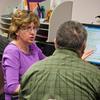
First published Jan. 1, 1993
In the fall of 2010, I was assigned to write a book report for my Death & Dying class. Looking over the list of ten books on the syllabus, I was unwilling to choose just one. I decided to read all ten.Among several good books about death and dying was Sherwin B. Nuland's How We Die: Reflections on Life's Final Chapter.
I just learned that Nuland died this week. He died on Monday, March 3rd. I have yet to write a review of his most important book, so as a tribute to him, I would like to do this today.
Because he is a surgeon by professional training, Nuland has the background to describe in technical terms how the body dies.
But Nuland is also an avid reader, a deep thinker, a previously published author, and a compassionate person. He also taught bioethics and medical history. Being a man of letters gave him the ability to humanize a very difficult topic.
His book includes narratives of various people in the dying process. They are presented as whole people with lives, loved ones, and their own perceptions of their impending death.
Nuland enriches the technical detail and the narratives of people in the dying process with quotes great works of literature. This allows his readers to think in more complex ways about the meaning of death--and the meaning of life.
His combined view as a scientist and a humanitarian produced a remarkable book. Not only was How We Die a bestseller with 500,000 copies sold worldwide. It won the 1994 National Book Award.
Nuland starts his book by explaining his purpose:
"I have written this book to demythologize the process of dying. My intention is not to depict it as a horror-filled sequence of painful and disguisting degradations, but to present it in its biological and clinical reality, as seen by those who are witness to it and felt by those who experience it. Only by frank discussion of the very details of dying can we best deal with those aspects that frighten us the most. It is by knowing the truth and being prepared for it that we rid ourselves of that fear of the terra incognita of death that leads to self-deception and disillusions." (xvii)Nuland starts with two chapters about how the heart functions, pointing out that the common denominator of most deaths is the lack of oxygen or nutrition. The third chapter ("Three Score and Ten") is about cerebral hemorrhages aka strokes. His own grandmother, whom he calls Bubbeh, provides the humanizing narrative for this manner of dying. But each chapter contains a tender-hearted description of a person confronted with death.
Most of the chapter titles are direct enough to indicate their contents:
- The Strangled Heart
- A Valentine--and How It Fails
- Three Score and Ten
- Doors to Death of the Aged
- Alzheimer's Disease
- Murder and Serenity
- Accidents, Suicide, and Euthanasia
- A Story of AIDS
- The Life of a Virus and the Death of a Man
- The Malevolence of Cancer
- Hope and the Cancer Patient
- The Lessons Learned
Nuland also acknowledges that even armed with enormous information, death has its own timetable and often takes a different path then people imagine. So he admonishes us to live each life fully and to do our best to accept what Shakespeare describes in Julius Caesar: "Seeing that death, a necessary end, Will come when it will come" (p. 262).
Thank you, Dr. Nuland. In teaching us how to die, we can learn so much about how to live. May you rest in peace.
Related:
Movies about Parents Active in the Dying Process
Special Exits: A Graphic Memoir

